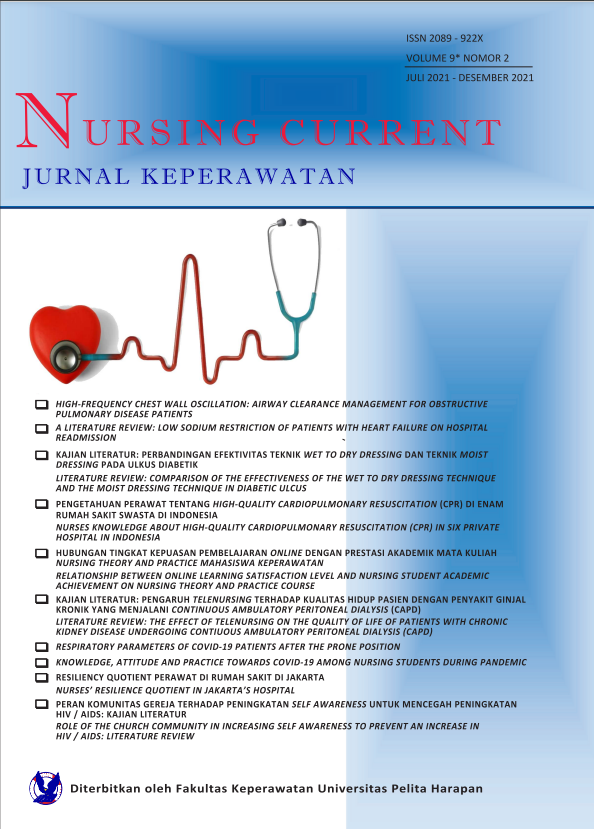HIGH-FREQUENCY CHEST WALL OSCILLATION: AIRWAY CLEARANCE MANAGEMENT FOR OBSTRUCTIVE PULMONARY DISEASE PATIENTS
DOI:
https://doi.org/10.19166/nc.v9i2.4916Schlagworte:
Airway clearance, HFCWO, High-frequency chest wall oscillation, Obstructive Pulmonary DiseaseAbstract
Ineffective mucous airway clearance is identified as the main concern in obstructive pulmonary disease. An impaired mucociliary mechanism and hyper secretive are leading to mucous retention. High-frequency chest wall oscillation (HFCWO) offers a great practical advantage for obstructive pulmonary disease treatment. A literature review was conducted to summarize the existing research evidence assessing the effectiveness and benefits of HFCWO as an airway clearance management among people with obstructive pulmonary disease. Literature was limited to accessible articles in the English language and sourced from electronic databases, PubMed and EBSCO, from their published date through 2010. Seven studies that fulfilled the inclusion criteria were included in the analysis. Two themes were identified from the summary of included studies, namely respiratory function improvement and quality of life outcomes. The overall results of the studies indicate that HFCWO positively affects health status and wellbeing in patients with excessive mucous production and impaired airway clearance mechanism. It also can be performed independently and enhances self-satisfaction. Thus, it will be advantageous to include the HFCWO in pulmonary rehabilitation. Further studies are needed to validate the effectiveness of HFCWO in obstructive pulmonary disease patients and develop better treatments in this field.
Literaturhinweise
Farida. (2011). Kepemimpinan Efektif dan Motivasi Kerja Dalam Penerapan Komunikasi Terapeutik Perawat. Jurnal Ners, 6(1), 31- 41. http://dx.doi.org/10.20473/jn.v6i1.3963
Hidayat, I. (2017). Hubungan Motivasi dan Beban Kerja Perawat Pelaksanaan dengan Kinerja Perawat di Ruang Rawat Inap Rumah Sakit Pelamonia Makassar. SKRIPSI. Fakultas Kesehatan Masyarakat, Universitas Hasanuddin. http://digilib.unhas.ac.id/uploaded_files/temporary/DigitalCollection/MjIxZDdiY2 NkMzI0Y2Q2NmQ2YzJmOWI1NWMzNTVkNWM4NmRlNGE5OA==.pdf
Himawan, R., & Hartinah, D. (2016). Hubungan Komunikasi Terapeutik Verbal dan NonVerbal Perawat dengan Tingkat Kecemasan Keluarga Pasien di Instalasi Perawat Intensif Rumah Sakit Umum Daerah Kabupaten Kudus. The 4th University Reserch Coloquium. https://publikasiilmiah.ums.ac.id/bitstream/handle/11617/7820/MIPA%20DAN%2 0KESEHATAN_46.pdf?sequence=1&isAllowed=y
Lisfyanti, R. (2015). Hubungan Motivasi Instrinsik dengan Penerapan Komunikasi Terapeutik Perawat pada Pasien Rawat Inap Kelas III RSUD Panembahan Senopati Bantul Yogyakarta. KARYA TULIS ILMIAH. Program Studi Ilmu Keperawatan, Fakultas Kedokteran dan Ilmu Kesehatan, Universitas Muhammadiyah Yogyakarta. http://thesis.umy.ac.id/datapublik/t53331.pdf
Mundakir. (2013). Komunikasi Keperawatan Aplikasi dalam Pelayanan. Yogyakarta, Indonesia: Graha Ilmu.
Nugroho, A. D. (2012). Hubungan Motivasi Kerja Perawat dengan Pemberian Pelayanan Keperawatan pada Pasien Keluarga Miskin (Jamkesmas) di RSUI Kustati Surakarta. SKRIPSI. Fakultas Ilmu Kesehatan, Universitas Muhammadiyah Surakarta. http://eprints.ums.ac.id/20579/
Nurazizah, D., & Isnaeni, D. S. (2013). Hubungan Motivasi Kerja Perawat dengan Pelaksanaan Peran Perawat sebagai Edukator di Ruang Rawat Inap RSUD Kajen Kabupaten Pekalongan. SKRIPSI. Program Studi Sarjana Keperawatan, STIK Muhammadiyah Pekajangan Pekalongan.
Potter, P. A., & Perry, A. G. (2010). Fundamental Keperawatan (7th ed.). Jakarta, Indonesia: Salemba Medika.
Putra, A. (2013). Hubungan Komunikasi Terapeutik Perawat dengan Kepuasan Pasien di Ruang Rawat Inap Rumah Sakit Umum Daerah DR. Zainoel Abidin. Jurnal Ilmu Keperawatan, 1(1), 49-54. http://jurnal.unsyiah.ac.id/JIK/article/view/4997/4250
Roatib, A., Suhartini, Supriyadi. (2007). Hubungan Antara Karakteristik Perawat dengan Motivasi Perawat Pelaksana dalam Menerapkan Komunikasi Terapeutik Pada Fase Kerja Di Rumah Sakit Islam Sultan Agung Semarang. Jurnal Undiversitas Diponegoro, 1(1). https://ejournal.undip.ac.id/index.php/medianers/article/view/223/124
Sasmito, P., Majadanlipah, Raihan, & Ernawati. (2018). Penerapan Teknik Komunikasi Terapeutik oleh Perawat pada Pasien. Jurnal Kesehatan, 11(2). https://doi.org/10.32763/juke.v11i2.87
Sitepu, E. C. B. (2012). Hubungan Motivasi dengan Penerapan Komunikasi Terapeutik oleh Perawat pada Pasien di Ruang Rawat Inap Rumah Sakit Jiwa Dr. Soeharto Heerdjan Jakarta. SKRIPSI. Program Studi Ilmu Keperawatan, Universitas Indonesia. http://lib.ui.ac.id/file?file=digital/20299087-S1654-Hubungan%20motivasi.pdf
Suryandika, M. (2016). Hubungan Motivasi Kerja dengan Kinerja Perawat di Instalasi Rawat Inap Rumah Sakit Omni Alam Sutera. SKRIPSI. Program Studi Kesehatan Masyarakat, Universitas Esa Unggul. https://digilib.esaunggul.ac.id/UEUUndergraduate-201231089/798
Syukri. (2012). Hubungan Motivasi Perawat dengan Komunikasi Terapeutik Perawat Pelaksana di Ruang Rawat Inap RSUD Dr. Zainoel Abidin Banda Aceh. SKRIPSI. Program Studi Ilmu Keperawatan. Universitas Syiah Kuala, Banda Aceh. https://etd.unsyiah.ac.id/index.php?p=show_detail&id=5503
Timby, B. K. (2009). Fundamental nursing skills and concepts (9th ed.). Philadelphia, PA: Lippincott Williams & Wilkins.
Downloads
Veröffentlicht
Zitationsvorschlag
Ausgabe
Rubrik
Lizenz
Authors who publish with this journal agree to the following terms:
1) Authors retain copyright and grant the journal right of first publication with the work simultaneously licensed under a Creative Commons Attribution License (CC-BY-SA 4.0) that allows others to share the work with an acknowledgement of the work's authorship and initial publication in this journal.
2) Authors are able to enter into separate, additional contractual arrangements for the non-exclusive distribution of the journal's published version of the work (e.g., post it to an institutional repository or publish it in a book), with an acknowledgement of its initial publication in this journal.
3) Authors are permitted and encouraged to post their work online (e.g., in institutional repositories or on their website). The final published PDF should be used and bibliographic details that credit the publication in this journal should be included.

This work is licensed under a Creative Commons Attribution-ShareAlike 4.0 International License.






